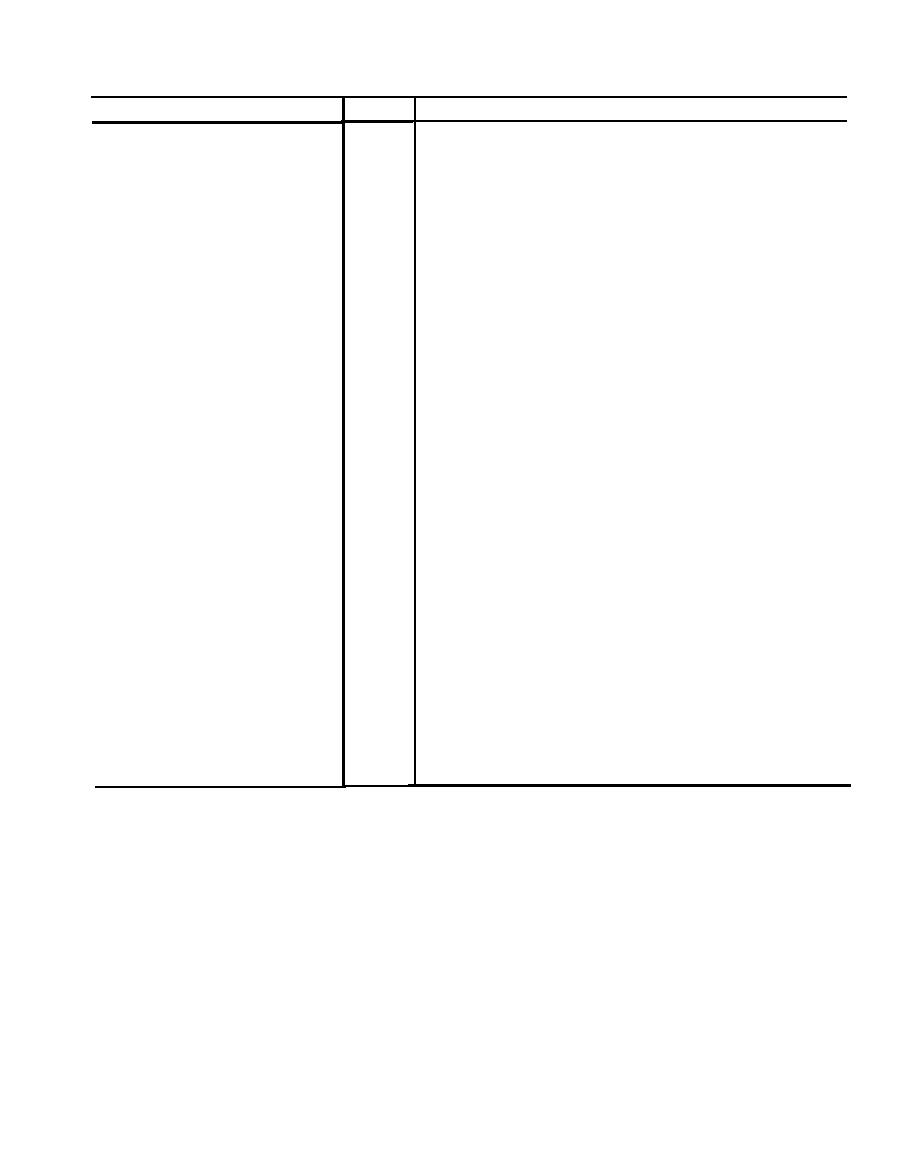 |
|||
|
|
|||
|
|
|||
| ||||||||||
|
|
 TM
11-6625-2843-14
Table 2-1. Operator's Controls
Switch
Control, indicator (or
Function
connector)
position
Establishes
continuously
variable
reference
between
O
and
360
degrees
by
Transmitter
1
which synchronous and servoed indicators are tested. The reference is varied
by means of a manually controlled knob.
Selects the appropriate teat circuitry for the under test.
TEST
SEL
2
switch
(6-position
rotary)
Used
for
testing
of
synchronous
indicators.
SYN
IND
SERVO
Used for testing of servoed indicators.
MOTOR
Ueed for testing of low-inertia motors.
Disables
test
circuits.
OFF
TRANS
Used
for
testing
DIFF
Used
for
testing
differential
Indicator 3
Provides
a
reference
when
testing
and
differential
SYN IND 4 switch (2-position)
When enabled by TEST SEL 2 switch, selects the test circuit for the type of
teat
being
performed
on
synchronous
indicator.
E-Z
Used for checking electracal zero.
CAL
Used
when
perform
tests.
MOTOR VOLTS FXD 5 control
Varies
voltage
applied
to
fixed-phase
windings
of
low-inertia
motors
when
MOTOR VOLTS 7 switch is set to FXD and TEST SEL 2 switch is set to
MOTOR. The applied voltage is available at VTVM binding peats 21 and 22.
MOTOR VOLTS VAR 6 control
Varies
voltage
applied
to
variable-phase
windings
of
low-inertia
motors
when
MOTOR VOLTS 7 switch is set to VAR and TEST SEL switch is set to
MOTOR. The applied voltage is available at VTVM bindings peats 21 and 23.
MOTOR VOLTS 7 switch (3-position rotary)
Selects
voltage
source
applied
to
low-inertia
motor
under
teat
and
to
VTVM
binding posts 21 and 22. When TEST SEL 2 switch is aet to MOTOR.
Applies 26 volts to fixed-phase and variable-phaee windings of law-inertia
FULL
motor.
Applies 26 volts through FXD 5 control to the fixed-phase windings of low-in-
FXD
ertia motor.
Applies
26
volts
through
MOTOR
VOLTS
VAR
6
control
to
the
variable-
VAR
phase
windings
of
low-inertia
motor.
Varies gain of servoamplifier in test set.
AMPLIFIER
GAIN
8
control
Provides electrical connection between test net and unit under teat.
TEST
UNIT
9
connector
Provides electrical connection of test set to power source.
POWER-INPUT
10
connector
Provides overload protection in 115-volt return line.
1A
FUSE
11
Provides overload protection in 26-volt line.
1A
FUSE
12
Provides overhead protection in 115-volt line.
3/8A FUSE 13
Spare
l-ampere
fuse.
SPARE
FUSE
14
spare 3/8-ampere fuse.
SPARE
FUSE
15
Lights when power is applied to test aet and POWER 17 switch is set to ON.
Power
16
indicator
Removes
power
from
test
set.
OFF
POWER
17
switch
Applies 115-volt, 400-hertz, single phase power to test act.
ON
(2 position toggle)
Provides
26-volt
monitoring
point.
26V 18,19 binding posts
Provides
10.8
volt
monitoring
point.
10.8V
19,20
binding
posts
Provides
monitoring
point
for
fixed-phase
voltage,
variable-phase
voltage,
and
VTVM
21,22
binding
posts
servo
nulls.
to a test bench, connect 115-volt, 400-Hertz,
Preliminary
Starting
Procedure
single phase power source to POWER-INPUT
The following steps are used to setup the test set for
1 0 connector using power source cable A, do
a n y operating sequence. No other preliminary or initial
n o t use power source cables E, F, and G.
adjustment procedures are required.
a. Set
POWER
17
switch
to
off.
Operating
Procedures
for
Syn-
b. Set
TEST
SEL
2
to
OFF.
chronous
Indicator
Test
c. R o t a t e M O T O R V O L T S F X D 5 a n d m o t o r v o l t s
Operating procedures for the synchronous indicator
FXD VAR 06 controls fully counterclockwise.
t e s t include an initial test, an electrical zero check, and
d. R o t a t e A M P L I F I E R G A I N 8 c o n t r o l f u l l y c o u n -
terclockwise.
a calibration procedure.
e. C o n n e c t t e s t a d a p t e r c a b l e
G
(QB86030-1)
to
a. Initial Test.
TEST UNIT 9 connector.
(1) Disconnect the aircraft cable to the syn-
NOTE
chronous indicator under test.
The following operating procedures assume
(2) Determine if the indicator under test is a
the instrument under test is located within
single unit or a dual unit. If it is a single unit, omit (5)
the aircraft. When applying these procedures
2-3
|
|
Privacy Statement - Press Release - Copyright Information. - Contact Us |